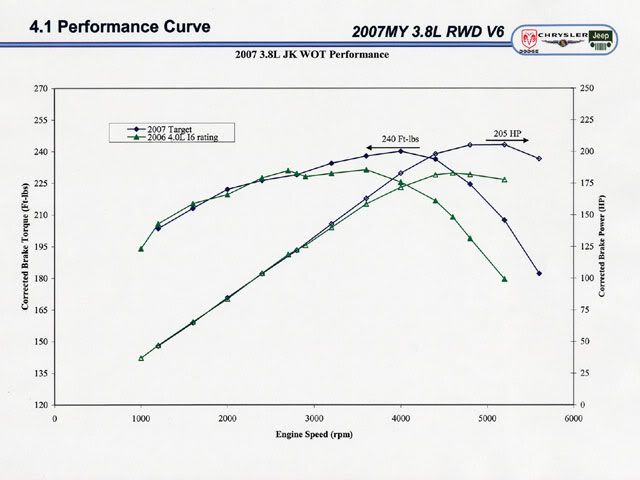I found the overlaid torque and HP curves of the 3.8 and the 4.0.
As I recalled, the differences are all but non-existant until 3000rpms, when the 3.8 climb away on the torque curve and begins to climb away on HP too.
I think I figured out how to post the graph, here goes:

Here's a graph of the Hemi torque and HP, its SAE corrected and the engine was run with all accessories and exhaust. But its the pre-VVT Hemi, the 2009 and later VVT has more HP and more torque along with a flatter torque curve, the LX/Grand Cherokee version has 375HP max, can't recall the torque, at least 375lbs'; the truck version has ~395HP and 425lbs' torque, iirc. I have the LX/GC vesion.

Here it is resized, it get blurry, still readable though.

Write up goes wih he Hemi graph:
Fig 1This power curve showing 345hp and 375 lbs.-ft. of torque is impressive enough as is, but consider this: it is SAE corrected which shows numbers some 2 percent less and this is the output with the accessories and a full exhaust. In our estimate, this compares with a standard corrected motor of about 395 lbs.-ft. and 365hp.
Just to have all of the graphs in one post for comparison, here's the 3.6 graph:

The 3.6 doesn't look to shabby compared to the 4.0 or the 3.8, eh? And talking about a flat torque curve..., wow.
JPK
As I recalled, the differences are all but non-existant until 3000rpms, when the 3.8 climb away on the torque curve and begins to climb away on HP too.
I think I figured out how to post the graph, here goes:
Here's a graph of the Hemi torque and HP, its SAE corrected and the engine was run with all accessories and exhaust. But its the pre-VVT Hemi, the 2009 and later VVT has more HP and more torque along with a flatter torque curve, the LX/Grand Cherokee version has 375HP max, can't recall the torque, at least 375lbs'; the truck version has ~395HP and 425lbs' torque, iirc. I have the LX/GC vesion.

Here it is resized, it get blurry, still readable though.

Write up goes wih he Hemi graph:
Fig 1This power curve showing 345hp and 375 lbs.-ft. of torque is impressive enough as is, but consider this: it is SAE corrected which shows numbers some 2 percent less and this is the output with the accessories and a full exhaust. In our estimate, this compares with a standard corrected motor of about 395 lbs.-ft. and 365hp.
Just to have all of the graphs in one post for comparison, here's the 3.6 graph:

The 3.6 doesn't look to shabby compared to the 4.0 or the 3.8, eh? And talking about a flat torque curve..., wow.
JPK
Last edited:
